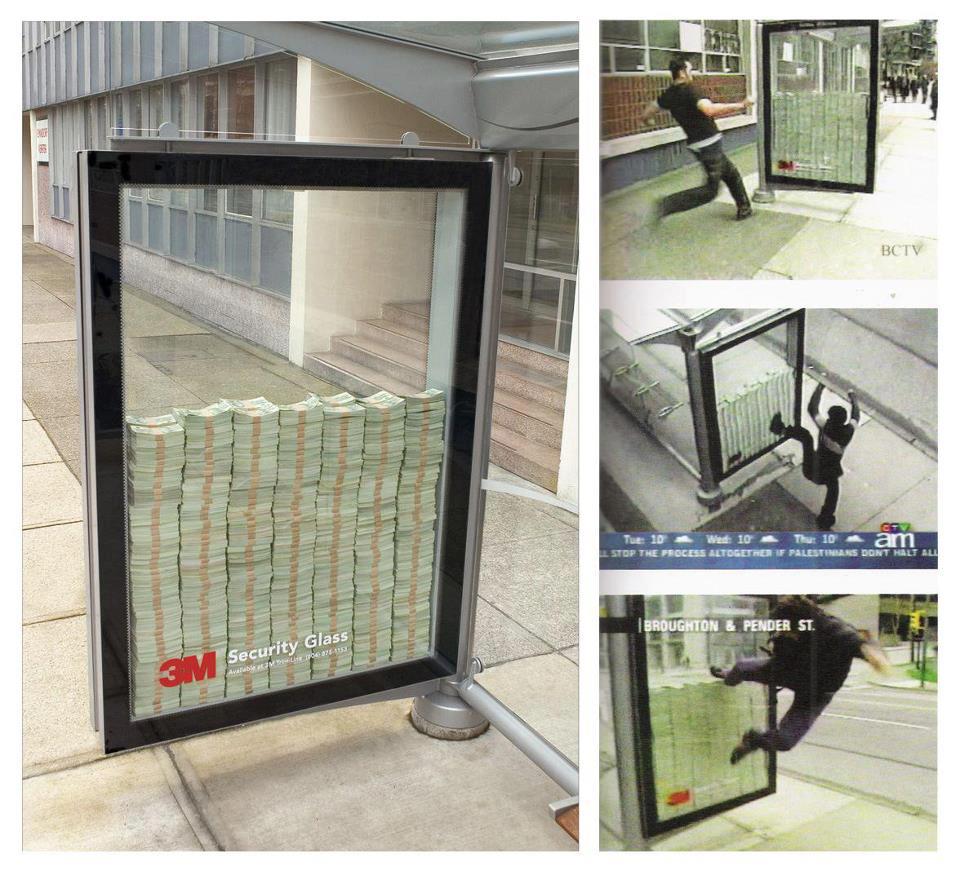So you have something valuable in your building that you want to protect, like children at a daycare or the entrance to a federal building, yet you want to be able to enjoy the beautiful sunshine and views of the outdoors, what do you do? Thankfully, there are decades of research and many manufactures out there that are able to provide you with products that can provide you a security solution for such a case.
 Figure 1: 3M put money inside a bus stop partition in Vancouver, Canada to prove their security glass could withstand nearly any attack by an unarmed person. If anyone could break the glass, they got the money. No one broke the glass.
Figure 1: 3M put money inside a bus stop partition in Vancouver, Canada to prove their security glass could withstand nearly any attack by an unarmed person. If anyone could break the glass, they got the money. No one broke the glass.
To tackle this problem, the first real question you have to ask is “what am I protecting against?” Are you trying to protect against a guy with a hammer breaking through your window, an active shooter, falling ice. The gamut is nearly limitless but needs to be defined early on in the decisions making process. Until you narrow that down, the options, and cost, are boundless. If you are trying to stop a burglar, that can be accomplished without too much trouble. If you are trying to stop an active shooter, or are looking for “blast protection”, things get complicated quickly.
The chart below lays out the major categories of protected glazing and potential materials that will accomplish that: Now if that table with all of those options looks confusing, it is. The worst part is that depending on manufacturer, one might make a glass-clad polycarbonate that is UL 752 level 3 rated that is ½” thick, where another might make the same apparent product that is ¾” thick. So how do you choose? It all comes down to what you are trying to protect against, and how important the aesthetic is. Even though many products pass the specific UL or ASTM testing requirements, they often vary in thickness, color, and physical make up and thus may not be suitable depending on the application.
Now if that table with all of those options looks confusing, it is. The worst part is that depending on manufacturer, one might make a glass-clad polycarbonate that is UL 752 level 3 rated that is ½” thick, where another might make the same apparent product that is ¾” thick. So how do you choose? It all comes down to what you are trying to protect against, and how important the aesthetic is. Even though many products pass the specific UL or ASTM testing requirements, they often vary in thickness, color, and physical make up and thus may not be suitable depending on the application.
Once a decision is made on what level of security you want and what type of material you want, you then have to struggle with how to secure this very expensive, but very dependable piece of glazing into place. Depending on the material and the manufacturer, you can use a captured system like a storefront or curtainwall system, you can use a custom designed steel framing system with glazing channels, or you might even be able to use mechanical fasteners to anchor through the material depending on its composition. The real factor in choosing the right framing system is the frame’s ability to withstand the kinetic energy distributed to it by the burglar / bullet / blast. Selecting the right frame typically requires engineering calculations and/or consulting a specific manufacturer to select a pre-engineered system.
If all of this sounds rather complicated, it’s because it is. NKB has done multiple projects where the design necessitated that some form of transparent security be provided, and each time we go through answering all of these questions in order to choose the right solution. Transparent security is a building component that requires special attention to detail and to ensure the right outcome. Do not just pick a product off the shelf when dealing with such complex problems, consult a design professional; broken glass in this case is a lot more dangerous than just a sharp edge.

